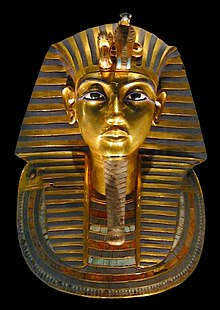Tutankhamun
Appearance
English
[edit]
Alternative forms
[edit]Etymology
[edit]Borrowed from Egyptian
(twt-ꜥnḫ-jmn, literally “Living Image of Amun”). The variant spellings of the final vowel are taken from variant forms of the name of the god Amun as found in various different sources: u from Coptic ⲁⲙⲟⲩⲛ (amoun), o from Ancient Greek Ἄμμων (Ámmōn), and e from the purely conventional system of Egyptological pronunciation.
| |
Pronunciation
[edit]Proper noun
[edit]Tutankhamun
- Ancient Egyptian pharaoh known for his young age and his tomb, which was preserved intact to the modern age.
Derived terms
[edit]- Tut (nickname)
Translations
[edit]Egyptian pharaoh
|
Further reading
[edit] Tutankhamun on Wikipedia.Wikipedia
Tutankhamun on Wikipedia.Wikipedia
Portuguese
[edit]Proper noun
[edit]Tutankhamun m
- Alternative form of Tutancâmon
Categories:
- English terms borrowed from Egyptian
- English terms derived from Egyptian
- English 4-syllable words
- English terms with IPA pronunciation
- English lemmas
- English proper nouns
- English uncountable nouns
- en:Ancient Egypt
- en:Individuals
- Portuguese lemmas
- Portuguese proper nouns
- Portuguese terms spelled with K
- Portuguese masculine nouns
